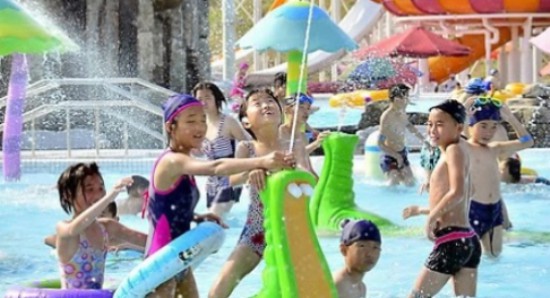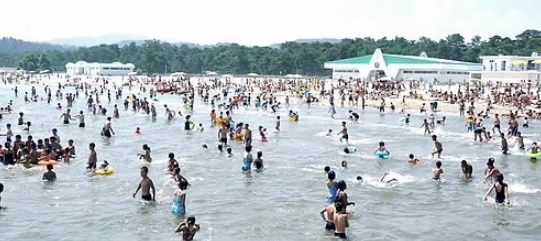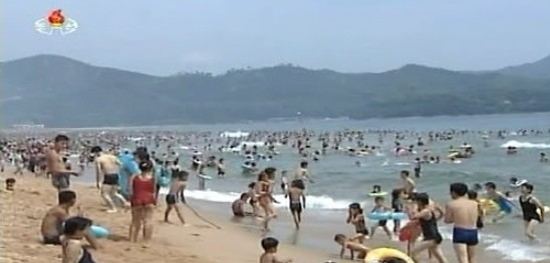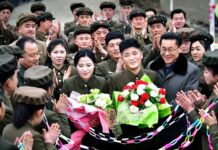The summer heat arrived early on the Korean Peninsula this year, and that means that beaches and
water parks on both sides of the DMZ are already bustling.
The North Korean
regime encourages people to swim, basing its approach on the logic that, as a peninsular nation, Korea is surrounded on three sides by water.
Since 1971, July and August have been designated for
swimming and water training.
Naturally, the state
media buttresses such goals in its reporting on North Korean society at this
time. On June 24th, Chosun Central News Agency followed
in this august tradition, conveying news of young people and workers having fun at Munsu
Water Park in Pyongyang.
 Munsu Water Park in Pyongyang. | Image: KCNA |
But apart from
infamous resorts on the banks of the Taedong River in the capital city, what are the best-known
of North Korea’s watery locales? The most celebrated are Songdowon and Myongsasimni, two sandy beaches near the city of Wonsan on the East
Sea coast.
In August last year,
KCNA described the atmosphere at Songdowon with reference to “the unusual sight
of students standing on the sandy beach with beautifully colored tubes slung
over their shoulders, and laughing grandparents, hand-in-hand with grandsons and granddaughters jumping
from foot to foot as they look out at the sea.”
 Songdowon in Wonsan, Gangwon Province. | Image: KCNA |
Myongsasimni, which
lies on the nearby Kalma Peninsula, is famed locally for a sandy beach that
stretches for more than 10-ri (1ri = 0.4km), as well
as the depth of its blue sea and multiple banks of Japanese (or Saltspray)
roses growing on the dunes.
“Many workers come
here when they have free time,” KCNA opined, again in August 2013, whilst showing footage of the local management office providing tubes and
goggles to users of the beach, as well as people playing volleyball.
In July 2013, the
North Korean authorities moved to raise tourist
revenues accrued via this beach at Myongsasimni by opening both the Kalma and
Saenal hotels. According to Pyongyang Broadcast, a North Korean radio
broadcaster targeting the outside world, “The Saenal Hotel has 18 floors and
can take as many as 200 guests at once.”
 Myongsasimni on the Kalma Peninsula, Gangwon Province. | Image: KCNA |
But for local people (rather than international tourists), the preference is for smaller local beaches and riverside locations. One senior defector told Daily
NK today, “When summer comes, the people just use the beaches where they live.”
Aside from problems of
time and money, there are also some quintessentially North Korean issues mitigating in favour of this choice to use local facilities, primary among
which is the difficulty of travelling freely between regions.
“North Korean beaches
can get money out of foreigners, but they aren’t going to get any from local people there to rest,” the informant went on. “Local people go to the valleys and reservoirs around
their houses, not to beaches like that.”

















